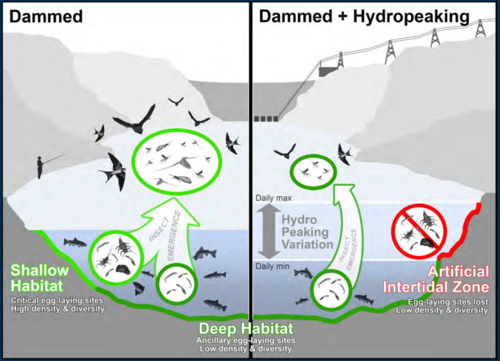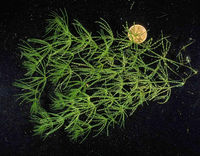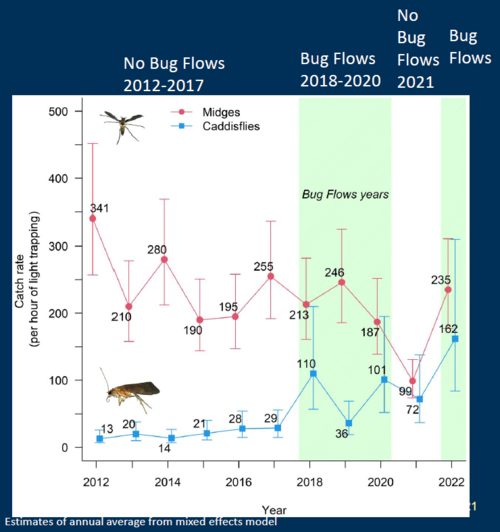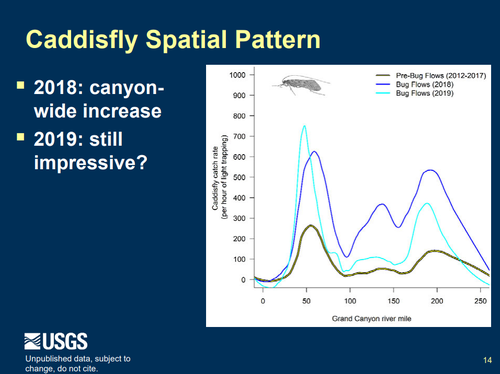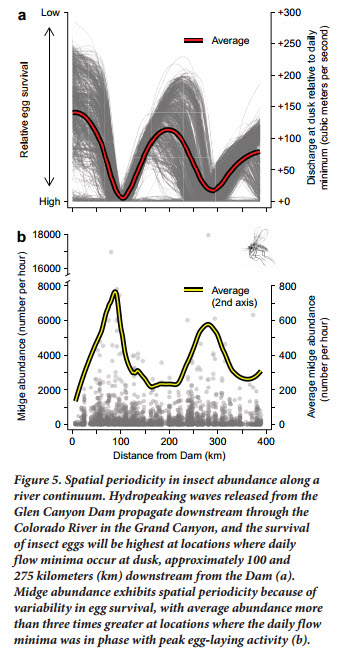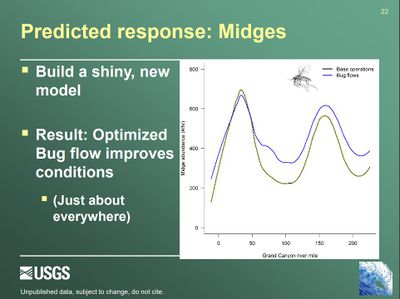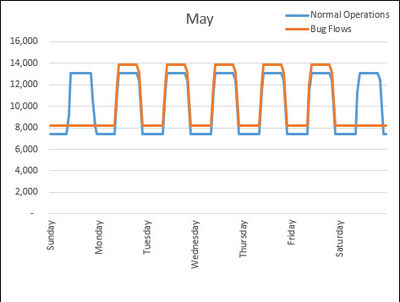Difference between revisions of "The Bugflow Experiment"
Cellsworth (Talk | contribs) |
Cellsworth (Talk | contribs) |
||
| (60 intermediate revisions by the same user not shown) | |||
| Line 17: | Line 17: | ||
</table> | </table> | ||
| − | [[File: | + | [[File:BugflowModel.PNG|thumb|center|500px|https://www.usbr.gov/uc/progact/amp/twg/2022-01-13-twg-meeting/20220113-AnnualReportingMeeting-ProjectF-AquaticEcologyFoodBaseMonitoring-508-UCRO.pdf]] |
<!-- | <!-- | ||
| Line 24: | Line 24: | ||
|style="width:60%; font-size:120%;"| | |style="width:60%; font-size:120%;"| | ||
| − | '''What is the “Macroinvertebrate Production Flow (MPF)" experiment?''' <br> | + | '''What is the “Macroinvertebrate Production Flow (MPF)" or "Bug Flow" experiment?''' <br> |
This would be an experimental release at Glen Canyon Dam to see if short-duration steady releases might increase the diversity and production of aquatic insects below Glen Canyon Dam. This experiment is included in the Preferred Alternative of the [http://gcdamp.com/index.php?title=Long-term_Experimental_and_Management_Plan_(LTEMP) LTEMP DEIS]. These “macroinvertebrate production flows” would occur from May to August and would maintain releases on the weekends to a level equal to the minimum release made during the week. This would allow aquatic insects two days a week throughout the river corridor to be able to lay their eggs at a stage where they would not be at risk of being dewatered or desiccated. The experiment would include monitoring to evaluate if the flows did increase the diversity and production of aquatic insects. The experiment was designed to test the hypothesis put forward in [[Media:Kennedy 2016 HydropowerEPT.pdf| '''Kennedy's 2016 BioScience Paper''']] while minimizing impacts to the hydropower resource at Glen Canyon Dam by having the steady flows on the weekend. This results in a transfer of water from the weekend to the weekdays increasing the daily minimums and maximums and the range of fluctuation during the week. Western believes that this experiment will result in only a small decrease in the energy value, but a modest increase in the capacity value of hydropower produced at Glen Canyon Dam. | This would be an experimental release at Glen Canyon Dam to see if short-duration steady releases might increase the diversity and production of aquatic insects below Glen Canyon Dam. This experiment is included in the Preferred Alternative of the [http://gcdamp.com/index.php?title=Long-term_Experimental_and_Management_Plan_(LTEMP) LTEMP DEIS]. These “macroinvertebrate production flows” would occur from May to August and would maintain releases on the weekends to a level equal to the minimum release made during the week. This would allow aquatic insects two days a week throughout the river corridor to be able to lay their eggs at a stage where they would not be at risk of being dewatered or desiccated. The experiment would include monitoring to evaluate if the flows did increase the diversity and production of aquatic insects. The experiment was designed to test the hypothesis put forward in [[Media:Kennedy 2016 HydropowerEPT.pdf| '''Kennedy's 2016 BioScience Paper''']] while minimizing impacts to the hydropower resource at Glen Canyon Dam by having the steady flows on the weekend. This results in a transfer of water from the weekend to the weekdays increasing the daily minimums and maximums and the range of fluctuation during the week. Western believes that this experiment will result in only a small decrease in the energy value, but a modest increase in the capacity value of hydropower produced at Glen Canyon Dam. | ||
| + | |||
| + | Bugflows were implemented May-August in 2018, 2019, 2020, and 2022. | ||
|}<!-- | |}<!-- | ||
| Line 43: | Line 45: | ||
|style="color:#000;"| | |style="color:#000;"| | ||
| + | [[File:MidgeCaddisCatch_2012to2022.PNG|thumb|center|500px| [[Media:Kennedy JuneTWG for BAO.pdf| Experimental Bug Flows Enhance Natural Processes That Sustain The Colorado River Ecosystem]] ]] | ||
| + | [[File:2019 caddis pattern.PNG|thumb|center|500px| [https://www.usbr.gov/uc/progact/amp/twg/2020-01-13-twg-meeting/20200113-AnnualReportingMeeting-Year2BugFlows-Presentation-508-UCRO.pdf| https://www.usbr.gov/uc/progact/amp/twg/2020-01-13-twg-meeting/20200113-AnnualReportingMeeting-Year2BugFlows-Presentation-508-UCRO.pdf] ]] | ||
|- | |- | ||
| Line 56: | Line 60: | ||
*Additionally, steady flows are know to reduce aquatic macroinvertebrate drift. Do increases in production and diversity, if observed, compensate for any decrease in drift? <br> | *Additionally, steady flows are know to reduce aquatic macroinvertebrate drift. Do increases in production and diversity, if observed, compensate for any decrease in drift? <br> | ||
| − | [[File:MidgeAbundanceFlow.jpg|thumb| | + | [[File:MidgeAbundanceFlow.jpg|thumb|center|400px| [http://gcdamp.com/images_gcdamp_com/7/70/Kennedy_2016_HydropowerEPT.pdf BioScience Paper] ]] |
| − | [[File: | + | [[File:BugflowsPrediction.JPG|thumb|center|400px| [https://www.usbr.gov/uc/progact/amp/twg/2018-01-25-twg-meeting/AR10.pdf https://www.usbr.gov/uc/progact/amp/twg/2018-01-25-twg-meeting/AR10.pdf] ]] |
| − | [ | + | |
|- | |- | ||
| Line 66: | Line 69: | ||
*[https://www.usgs.gov/centers/sbsc/science/citizen-science-light-trapping-grand-canyon?qt-science_center_objects=0#qt-science_center_objects Citizen Science light trap monitoring throughout Glen and Grand Canyons] | *[https://www.usgs.gov/centers/sbsc/science/citizen-science-light-trapping-grand-canyon?qt-science_center_objects=0#qt-science_center_objects Citizen Science light trap monitoring throughout Glen and Grand Canyons] | ||
| − | *Drift: every | + | *Drift: every 5 miles in Glen and Grand Canyons |
| − | + | *Weekday vs weekend drift | |
| − | *Weekday vs weekend drift | + | |
|- | |- | ||
| Line 75: | Line 77: | ||
|style="color:#000;"| | |style="color:#000;"| | ||
| − | *See | + | *See a smoothing of the spatial pattern in midges in Grand Canyon |
| − | * | + | *Increase in midges throughout Glen and Grand Canyons |
| − | * | + | *Increase in caddisflies (and other EPT) throughout Glen and Grand Canyons |
| − | + | ||
|} | |} | ||
| Line 114: | Line 115: | ||
|- | |- | ||
| − | ! <h2 style="margin:0; background:#cedff2; font-size:120%; font-weight:bold; border:1px solid #a3b0bf; text-align:left; color:#000; padding:0.2em 0.4em;"> | + | ! <h2 style="margin:0; background:#cedff2; font-size:120%; font-weight:bold; border:1px solid #a3b0bf; text-align:left; color:#000; padding:0.2em 0.4em;"> Resources that might be affected </h2> |
|- | |- | ||
|style="color:#000;"| | |style="color:#000;"| | ||
| Line 124: | Line 125: | ||
*Boater safety: Glen Canyon, downstream | *Boater safety: Glen Canyon, downstream | ||
*Sediment transport: beaches | *Sediment transport: beaches | ||
| + | |||
| + | |- | ||
| + | ! <h2 style="margin:0; background:#cedff2; font-size:120%; font-weight:bold; border:1px solid #a3b0bf; text-align:left; color:#000; padding:0.2em 0.4em;"> Financial costs of the experiment </h2> | ||
| + | |- | ||
| + | |style="color:#000;"| | ||
| + | |||
| + | *The cost of the 2018 Bugflow Experiment was $165,000 [https://publications.anl.gov/anlpubs/2019/06/151429.pdf] <br> | ||
| + | *The cost of the 2019 Bugflow Experiment was $327,000 [https://publications.anl.gov/anlpubs/2020/12/163982.pdf] <br> | ||
| + | *The cost of the 2020 Bugflow Experiment was $941,000 [[Media:2020BugFlowsFinancials.pdf| (3)]]<br> | ||
| + | The three-year (2018-2020) total of doing the Bugflow Experiment is $1,433,000 <br> | ||
| + | |||
| + | *The cost estimate for doing a Bugflow Experiment in 2021 (which wasn't implemented) was $1,021,000 <br> | ||
| + | *The cost of the 2022 Bugflow Experiment was $1,154,000 [https://publications.anl.gov/anlpubs/2019/06/151429.pdf] <br> | ||
|- | |- | ||
| Line 139: | Line 153: | ||
|style="color:#000;"| | |style="color:#000;"| | ||
| + | '''2023''' | ||
| + | *[https://www.usbr.gov/uc/progact/amp/twg/2023-04-13-twg-meeting/20230413-BugsPayDaysSteadyReservoirReleases-508-UCRO.pdf Bugs pay for days of steady reservoir releases] | ||
| + | *[https://www.usbr.gov/uc/progact/amp/amwg/2023-02-16-amwg-meeting/20230216-ScienceUpdateLakePowellRiparianVegetationBugFlows-508-UCRO.pdf Science Update: Lake Powell, Riparian Vegetation, and Bug Flows] | ||
| + | *[[Media:Kennedy JuneTWG for BAO.pdf| Experimental Bug Flows Enhance Natural Processes That Sustain The Colorado River Ecosystem]] | ||
| + | *[[Media:1100_TWGQnA_bugflow_20230615.pdf| Bugflows Q&A]] | ||
| + | *[https://www.usbr.gov/uc/progact/amp/twg/2023-01-26-twg-meeting/20230126-AnnualReportingMeeting-BugFlowsFoodBaseUpdate-508-UCRO.pdf Project F: Bug Flows and food base update] | ||
| + | |||
| + | '''2022''' | ||
| + | *[https://www.usbr.gov/uc/progact/amp/amwg/2022-08-18-amwg-meeting/20220818-Kennedy_Update_Bug_Flow_AMWG_BAO_508.pdf Update on the Bug Flow Experiment: Background, Monitoring, and New Analyses] | ||
| + | *[[Media:Decision Memo on Bug Flows 2022 08 12.pdf| August 2022 BugFlow Decision memo]] | ||
| + | *[[Media:Summary Bug Flow Tech Analyses and Comments 2022 08 12.pdf| August 2022 Summary Bug Flow Tech Analyses and Comments ]] | ||
| + | *[[Media:2022_BugFlow_Decision_memo_Final_wgp.pdf| April 2022 BugFlow Decision memo]] | ||
| + | *[[Media:2022.04.11 - Technical Recommendation Report - Bug Flows 2022 - FINAL wAttach - Copy.pdf| April 2022 Technical Recommendation Report]] | ||
| + | *[https://www.usbr.gov/uc/progact/amp/twg/2022-01-13-twg-meeting/20220113-AnnualReportingMeeting-DiscussionBugFlowsSynthesisReviewOpportunitiesSpringSummerFlowExperiments-508-UCRO.pdf Discussion of the Bug Flows Synthesis and Review & Opportunities for Spring and Summer Flow Experiments ] | ||
| + | *[https://www.usbr.gov/uc/progact/amp/amwg/2022-05-18-amwg-meeting/20220518-BugFlowsFY2022-508-UCRO.pdf Bug Flows FY2022 ] | ||
| + | |||
| + | '''2021''' | ||
| + | *[https://www.usbr.gov/uc/progact/amp/twg/2021-10-14-twg-meeting/20211014-MacroInvertebrateFlowExperimentFinancialImpactHydropower-Presentation-508-UCRO.pdf Macro Invertebrate Flow Experiment Financial Impact on Hydropower: Process and Methods] | ||
| + | *[https://www.usbr.gov/uc/progact/amp/twg/2021-04-14-twg-meeting/20210414-DiscussionAnticipatedScopeForthcomingBugFlowEvaluationDocument-508-UCRO.pdf Discussion of the Anticipated Scope of the Forthcoming Bug Flow Evaluation Document ] | ||
| + | *[https://www.usbr.gov/uc/progact/amp/twg/2021-01-22-twg-meeting/20210122-BugFlows-508-UCRO.pdf Bug Flows ] | ||
| + | |||
| + | '''2020''' | ||
| + | *[[Media:2020BugFlowsFinancials.pdf| Financial Analysis of the 2020 Glen Canyon Dam Bug Flow Experiment]] | ||
| + | *[https://www.usbr.gov/uc/progact/amp/twg/2020-10-15-twg-meeting/20201015-UpdateBugFlowsExperiment-Presentation-508-UCRO.pdf Update on the Bug Flows Experiment ] | ||
| + | *[https://www.usbr.gov/uc/progact/amp/amwg/2020-08-20-amwg-meeting/20200820-WY20LTEMPExp-AugAMWG.pdf Potential Water Year 2021 LTEMP Experiments & Bug Flow Update] | ||
| + | *[https://www.usbr.gov/uc/progact/amp/amwg/2020-05-20-amwg-meeting/20200520-AMWG-PotentialWaterYear2020LTEMPExperimentsBugFlowUpdate-508-UCRO.pdf Potential Water Year 2020 LTEMP Experiments & Bug Flow Update ] | ||
| + | *[https://www.usbr.gov/uc/progact/amp/twg/2020-04-15-twg-meeting/20200415-BugFlowsMonitoringResults-Presentation-508-UCRO.pdf Bug Flows Monitoring Results ] | ||
| + | *[https://www.usbr.gov/uc/progact/amp/amwg/2020-02-12-amwg-meeting/20200212-GCMRC2020AnnualReportingMeeting-PresentationPart1-508-UCRO.pdf GCMRC 2019 Annual Reporting Meeting Overview – Part 1 ] | ||
| + | *[https://www.knau.org/post/colorado-river-bugs-spark-two-unprecedented-experiments-opposite-goals Colorado River Bugs Spark Two Unprecedented Experiments With Opposite Goals] | ||
| + | *[https://www.usbr.gov/newsroom/newsrelease/detail.cfm?RecordID=70708 Water experiment to be conducted along the Colorado River while maintaining hydropower production this summer] | ||
| + | *[[Media:2020-04-24 ASWS Approval Memo on Implementing Bug Flows.pdf| Approval of recommendation for macroinvertebrate production flow releases at Glen Canyon Dam, May 1 through August, 2020]] | ||
| + | *[[Media:Attachment - FINAL 2020 GCD Planning Implementation Team Bug Flows Recommendation Report.pdf| 2020 GCD Planning Implementation Team Bug Flows Recommendation Report]] | ||
| + | *[[Media:Metcalf etal 2020 Bug flows Don't count your midges-BQR article.pdf |Metcalfe et. al., 2020, Bug flows--Don't count your midges until they hatch: Boatman's Quarterly Review]] | ||
| + | *[https://www.usbr.gov/uc/progact/amp/twg/2020-01-13-twg-meeting/20200113-AnnualReportingMeeting-TroutRecruitmentGrowthPopulationDynamics-Presentation-508-UCRO.pdf TRGD: Trout Recruitment, Growth and Population Dynamics ] | ||
| + | *[https://www.usbr.gov/uc/progact/amp/twg/2020-01-13-twg-meeting/20200113-AnnualReportingMeeting-Year2BugFlows-Presentation-508-UCRO.pdf Year 2 of Bug Flows ] | ||
| + | |||
| + | '''2019''' | ||
| + | *[[Media:2019BugFlowsFinancials.pdf| Financial Analysis of the 2019 Glen Canyon Dam Bug Flow Experiment]] | ||
| + | *[[Media:2019-04-24 ASWS Decision Memo on Implementing Bug Flows.pdf| ASWS Decision Memo on Implementing Bug Flows]] | ||
| + | *[[Media:2019 GCD Planning Implementation Team Bug Flows Recommendation Report final.pdf| 2019 GCD Planning Implementation Team Bug Flows Recommendation Report]] | ||
| + | *[[Media:2019-04-19 GCD Planning Implementation Team Bug Flows Recommendation to GCD Leadership Team.pdf| GCD Planning Implementation Team Bug Flows Recommendation to GCD Leadership Team]] | ||
| + | *[https://www.usbr.gov/uc/progact/amp/twg/2019-03-14-twg-meeting/20190314-BugFlowsImplementationResourceResponse-Presentation-508-UCRO.pdf Bug Flows Implementation and Resource Response Presentation ] | ||
*[https://www.usbr.gov/uc/progact/amp/amwg/2019-03-06-amwg-meeting/20190306-ModelingInputBugflowExperimentSummer2018-Presentation-508-UCRO.pdf Modeling Input for the Bugflows Experiment - Summer, 2018 Presentation] | *[https://www.usbr.gov/uc/progact/amp/amwg/2019-03-06-amwg-meeting/20190306-ModelingInputBugflowExperimentSummer2018-Presentation-508-UCRO.pdf Modeling Input for the Bugflows Experiment - Summer, 2018 Presentation] | ||
| + | *[https://www.usbr.gov/uc/progact/amp/twg/2019-03-14-twg-meeting/20190314-BugFlowsImplementationResourceResponse-Presentation-508-UCRO.pdf Bug Flows Implementation and Resource Response Presentation ] | ||
| + | |||
| + | '''2018''' | ||
| + | *[https://publications.anl.gov/anlpubs/2019/06/151429.pdf Financial Analysis of the 2018 Glen Canyon Dam Bug Flow Experiment] | ||
*[https://www.usbr.gov/uc/progact/amp/amwg/2018-08-22-amwg-meeting/Attach_05.pdf Do bug flows result in better fishing? PPT] | *[https://www.usbr.gov/uc/progact/amp/amwg/2018-08-22-amwg-meeting/Attach_05.pdf Do bug flows result in better fishing? PPT] | ||
*[https://www.usbr.gov/uc/progact/amp/amwg/2018-08-22-amwg-meeting/Attach_04.pdf Update on the Progress of the Bug Flow Experiment PPT ] | *[https://www.usbr.gov/uc/progact/amp/amwg/2018-08-22-amwg-meeting/Attach_04.pdf Update on the Progress of the Bug Flow Experiment PPT ] | ||
| Line 146: | Line 206: | ||
*[[Media:2018 GCD Experimental Technical Team Report final.pdf| 2018 GCD Experimental Technical Team Report - Bugflows]] | *[[Media:2018 GCD Experimental Technical Team Report final.pdf| 2018 GCD Experimental Technical Team Report - Bugflows]] | ||
*[https://www.usbr.gov/uc/progact/amp/twg/2018-01-25-twg-meeting/AR10.pdf Bug flow optimizations and predictions PPT] | *[https://www.usbr.gov/uc/progact/amp/twg/2018-01-25-twg-meeting/AR10.pdf Bug flow optimizations and predictions PPT] | ||
| + | |||
| + | '''2016''' | ||
*[[Media:Kennedy 2016 HydropowerEPT.pdf| Kennedy et al. 2016. Flow Management for Hydropower Extirpates Aquatic Insects, Undermining River Food Webs. BioScience]] | *[[Media:Kennedy 2016 HydropowerEPT.pdf| Kennedy et al. 2016. Flow Management for Hydropower Extirpates Aquatic Insects, Undermining River Food Webs. BioScience]] | ||
*[https://undark.org/article/wilo-doyle-colorado-river-insects/ Deep in the Grand Canyon, Scientists Struggle to Bring Back the Bugs] | *[https://undark.org/article/wilo-doyle-colorado-river-insects/ Deep in the Grand Canyon, Scientists Struggle to Bring Back the Bugs] | ||
| Line 205: | Line 267: | ||
TMF experiments, and this will be discussed during the communication and consultation process | TMF experiments, and this will be discussed during the communication and consultation process | ||
as described in Section 2.2.4.4. | as described in Section 2.2.4.4. | ||
| + | |||
| + | Target two to three replicates (Table 2-9, Page 2-54). | ||
==[https://www.fws.gov/southwest/es/arizona/Documents/Biol_Opin/120059_LTEMP%20BiOp_11-25-16.pdf LTEMP Biological Assessment, pages 30-41 ]== | ==[https://www.fws.gov/southwest/es/arizona/Documents/Biol_Opin/120059_LTEMP%20BiOp_11-25-16.pdf LTEMP Biological Assessment, pages 30-41 ]== | ||
| Line 219: | Line 283: | ||
|- | |- | ||
|style="color:#000;"| | |style="color:#000;"| | ||
| + | |||
| + | [[File:BugflowHydrograph.jpg|thumb|center|400px|Example of an experimental Macroinvertebrate Production Flow (MPF) hydrograph]] | ||
==Modeling Assumptions:== | ==Modeling Assumptions:== | ||
Latest revision as of 10:56, 7 December 2023
|
|
What is the “Macroinvertebrate Production Flow (MPF)" or "Bug Flow" experiment? Bugflows were implemented May-August in 2018, 2019, 2020, and 2022. |
| EPT as Biologic Indicators of Stream Condition |
Algae and Aquatic Macrophytes |
Aquatic Macroinvertebrates |
|---|
|
|
